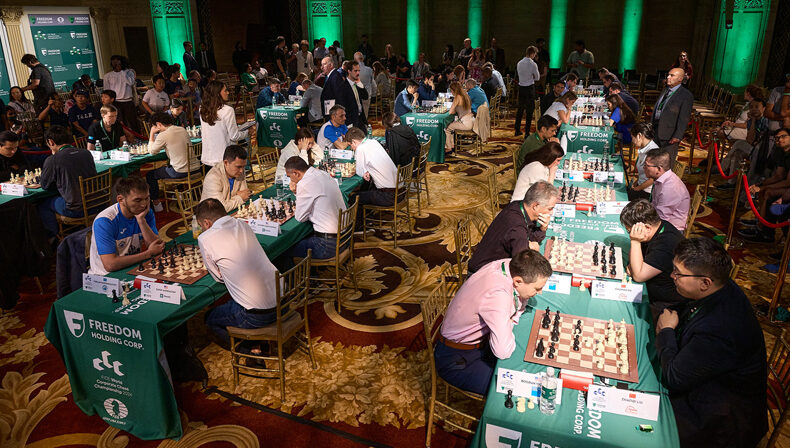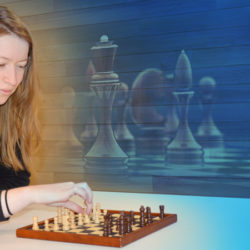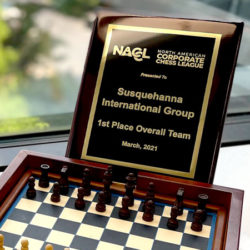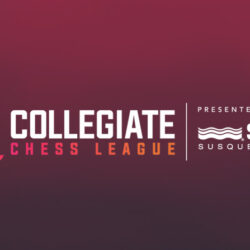
Susquehanna recently competed in the World Corporate Chess Championship. The tournament – run by FIDE, the governing body of international chess competition – brought participants from over 350 companies across 55 countries to compete to be considered the “smartest company in the world.”
Teams were required to have at least one male and one female player and were only allowed to have one member with a FIDE standard rating above 2400. We were also allowed to have one non-employee, invited player. In our case, we were lucky enough to be joined by former US Champion Sam Shankland.
In team chess tournaments, teams typically have a 4-person ordered lineup. A match consists of 4 games played concurrently: one between each team’s “board 1” player, another between each team’s “board 2” player, and so on. To keep the matches relatively balanced, the “white” team in the pairing plays white on boards 1 and 3 and black on boards 2 and 4. Players are not allowed to communicate during the matches or advise each other on decisions (e.g. whether to accept a draw).
At the start of the tournament, teams set the order of their lineup. They are allowed to choose any permutation of their 4 players. Occasionally, teams will seat players out of rating order – referred to as “stacking” – as a strategy to increase match win probability.
There were multiple rounds of online qualifiers. Our initial qualifier was a Rapid (G/10 +2) online tournament. The top eight teams advanced to the online knockout phase. Seven similar qualifiers took place, creating a total pool of 64 teams that moved on to the knockout phase.
The teams were then divided into eight pools, with each pool having equal representation from each qualifier and finishing seed (1st – 8th). The knockout phase was a 6-round Swiss System Tournament. We finished in 1st place with a score of 20.5/24, securing a spot in the over-the-board finals in New York.
Seven other teams qualified: Deutsche Bank, LLC Greco, UBS, Tengizchevroil, Nanjing Spark Chess Technology, ChessMood, and Chessify. In addition, 4 wild card teams were invited to participate in the finals: Google, Goldman Sachs, Blackrock, and Freedom Holding Corp.
The 12 teams were separated into two pools for the group stage. A random draw was conducted, ensuring that each pool contained 4 standard qualifying teams and 2 wild cards. The group stage was a double round-robin — on the first day we played each team in our pool once and on the second day we played those same teams again, but with opposite colors.
In round 3, Ethan’s game against Qibiao Wang presented some interesting decisions about the tradeoffs between pawn structure, material, and piece activity.
Sam had a strong win against GM Zaven Andriasian from Chessify.
Over these first two days, we played 10 rounds for a total of 40 individual Rapid games. Advancement to the next stage was based off game points, with the top two finishers from each group progressing. We finished second in our division behind Chessify.

In the semifinals, we were paired against the #1 seed from the other pool, ChessMood. They were very strong, with many particularly skilled rapid and blitz players. This was a double round — each player would play their opponent twice (once with each color). Essentially, it was a best-of-8 match, with the result coming down to a blitz playoff in the case of a tie.
This was going to be a tough match, but we had time to prepare and study our opponents. Based on our Elo ratings, our expected score was 2.9 game points with only 8.1% chance of a clear win (green region) and a 10.4% chance of a tie (blue region).

In our first set of games in the semifinals, Nan had a strong upset win on board 2.
Despite this strong victory, we lost the match 3-5. In the other match Chessify beat UBS. So the finals were set: Chessify vs ChessMood.
We still had the third-place match against UBS. They stacked their roster so their weakest player was on board 1. While it can be a handicap when facing certain lineup distributions, this strategy had gotten them far, because they were able to increase their win probability on the lower boards quite significantly.
Our expected score in this match was 3.64 game points (as opposed to 4.4 had UBS ordered their lineup in standard rating order) with a 25.2% chance of a clear win and a 19.7% chance of a tie.

We came out victorious 5.5-2.5! We not only finished third in the tournament, but also were the best team from the United States and best non-chess company.
Our team thoroughly enjoyed the event, and will be studying up for next year. A special shoutout to Jennifer Yu and Viktor Matviishen for their advice during the finals – we couldn’t have done it without you!

Photo credit: Rafal Oleksiewicz




Subscribe Now
Get each new post sent straight to your inbox